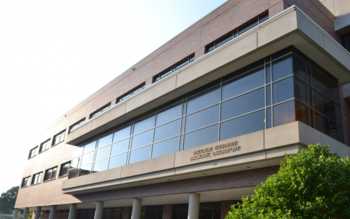McKenna to retire from Wisconsin Veterinary Diagnostic Laboratory
They say blood is thicker than water. So much so, that even the volume of water in all of Madison’s lakes is still too thin for Thomas McKenna, director of the Wisconsin Veterinary Diagnostic Laboratory (WVDL). After seven years in the role, he is officially retiring from the lab and moving to Massachusetts to be closer to his grown daughters.

Thomas McKenna
Associate Director Peter Vanderloo will step in as interim director upon McKenna’s departure, delaying his own retirement until a replacement is found.
“We are sorry to leave Madison, it’s a great town to live in,” McKenna says of himself and his wife, a Wisconsin native and UW School of Veterinary Medicine graduate. “But you want to be near your kids. You don’t know what the future holds.”
McKenna will take a new position with the United States Department of Agriculture, in the Animal and Plant Health and Inspection Service’s Veterinary Services unit, as an assistant district director representing New England. He calls it a “smaller” job than the one he has fulfilled at WVDL.
The veterinary and livestock disease researcher joined WVDL in March 2007, shortly after the laboratory moved into its then-brand-new, $24 million facility on the west end of campus. Prior to coming to Madison, McKenna served as laboratory director at the federal Foreign Animal Disease Diagnostic Laboratory at the Plum Island Animal Disease Center on Long Island, New York.
McKenna brought a higher profile to the Wisconsin lab, says Vanderloo, with his expertise in animal diagnostics and testing and his experience in a national laboratory.

The Wisconsin Veterinary Diagnostic Laboratory is located on Easterday Lane near the School of Veterinary Medicine.
Photo: WVDL
With an annual operating budget of $9 million and a staff of 75, the WVDL performs services that range from testing of sick and dead animals for veterinarians working with producers across the U.S. to disease surveillance for the USDA. The lab serves Wisconsin’s dairy, beef, cattle and livestock industries by testing the health of bulls at the state’s semen centers, which produce frozen bovine semen for export both domestically and internationally.
The WVDL is also at the forefront of testing for chronic wasting disease (CWD), first detected in deer in the state in 2002. The transmissible spongiform encephalopathy laboratory at WVDL tested 6,592 deer for the Wisconsin Department of Natural Resources in 2013 and also tests animals from a number of other states and private deer farms. As part of its role in national disease surveillance, the lab screens for diseases similar to CWD, including mad cow disease and scrapie.
McKenna attributes much of the lab’s successes to the support it has received from the campus community. As he departs, he is confident he leaves it on solid footing; it was already in great shape when he got here, he says. He is also grateful to Vanderloo for agreeing to push his own retirement back until a new director can be found.
“Madison’s a terrific town and it was great being part of UW,” McKenna says. “There is so much great stuff going on there. It was a great seven years for me.”
Subscribe to Wisconsin Ideas
Want more stories of the Wisconsin Idea in action? Sign-up for our monthly e-newsletter highlighting how Badgers are taking their education and research beyond the boundaries of the classroom to improve lives.




